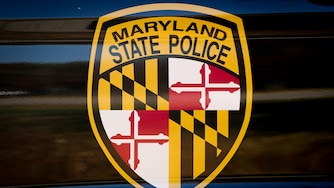Residents and advocates said two recent crashes between cars and cyclists in Southeast Baltimore highlight the need for better bike routes, stressing that small changes could make their neighborhoods safer for drivers and pedestrians alike.
The nonprofit Friends of Patterson Park, which organizes community events and programming for the iconic Southeast Baltimore green space, wanted last weekend’s group ride to highlight the lack of a safe east-west connection between the park and downtown, said Teddy Walsh, board president for the organization.
It could be poised to get its wish in the coming years after progressive, bike-friendly candidates had a strong showing during last week’s Democratic primary.
Roughly 50 cyclists, some riding with their children, met Sunday morning at the Northeast entrance to Patterson Park, a stone’s throw from where a bike commuter was struck by a car in mid-April. Walsh thanked the crowd for coming out before leading the pack through the park and onto East Baltimore Street toward downtown. Cars honked and waved as they drove past.
The Baltimore Banner thanks its sponsors. Become one.
“It’s just kind of crazy that this is the prescribed bike lane for the city,” Walsh said of Sunday’s route, which included crossing President Street by way of East Lombard Street, a major downtown intersection.
“I really appreciate that it [the ride] took us on the way that’s the technical route. ... I’ve never done that before because it just doesn’t feel safe,” said Annie Worth, a Southeast resident who said she rides her bike to her job downtown most days. Like many others in the community, she typically uses Bank and Gough streets, calmer one-way east-west streets also designated as bike routes, then connects to the Inner Harbor promenade winding through backstreets. Her dog Louie was along for the ride on Sunday, too.
There’s a need for more east-west bike connection, said Jed Weeks, executive director of advocacy organization Bikemore. With traffic limited around the construction of hundreds of new housing units between Gough and East Pratt streets just west of Broadway, it gives transportation officials the chance to repave one of the roads with separated bike lanes, Weeks said.
“There is an opportunity directly in front of us where we could start to address this tomorrow in planning if we wanted to,” said Weeks, who joined the Sunday ride. He said that those roads would be wide enough to accommodate a bike lane and that transportation officials should choose wherever will disrupt the least amount of parking.
The neighborhoods surrounding Patterson Park are some of the most walkable in the city, but lack bike infrastructure that could make the roads safer, said Mark Parker, a Lutheran pastor who recently won the Democratic nomination for the 1st District City Council seat. “This is where it’s not just ‘a nice to have,’ but it’s critically important for our neighbors.”
The Baltimore Banner thanks its sponsors. Become one.
Advocates and riders have long criticized the Baltimore City Department of Transportation’s implementation of bike lane plans for not connecting them into one contiguous network. Plans for slimming the nearby one-way, north-south Wolfe and Washington streets to car traffic and adding a bike lane that would connect to East Monument Street have been slow to materialize.
Parker, who said he often rides on Wolfe and Washington to go north-south, said he’s bullish on the proposed road diets as well as completing an unfinished section of the Greenway Trails Network that’s in the district he is projected to win in November.
He could have some help on the City Council. Avid cyclist and Complete Streets supporter Ryan Dorsey handily defeated his 3rd District City Council opponents; Zeke Cohen, a Dorsey ally whom Parker is replacing, will likely rise to the council’s top seat after ousting incumbent Nick Mosby.
Mayor Brandon Scott, whose administration has doubled down on its commitment to the Complete Streets framework of prioritizing pedestrians, bike and transit users in road design, got a decisive nod from voters to stick around for a second term.
Scott has faced criticism on both sides of the bike lane debate. Bike advocates have lamented the slow and disjointed progress of his transportation department’s commitment to build the lanes, while critics say city officials have failed to properly engage communities in big changes to their neighborhoods that make commuting harder.
The Baltimore Banner thanks its sponsors. Become one.
Critics of “road diet” projects like the redesign of 28th Street or Central Avenue say they clog up roadways with unnecessary congestion. Proponents say slower cars means safer streets, and that more people feeling safer to take two wheels instead of four means better traffic for everyone.
Walsh and others in his organization also see a need to improve paving conditions within Patterson Park. Organizers for the Maryland Cycling Classic, a yearly professional cycling race through parts of Baltimore County and Baltimore City, have deemed the bike route within the park unusable, Walsh said.
“During the pandemic we saw really an explosion of bike purchases and people wanting to learn to ride a bike,” said Katie Long, program director at Friends of Patterson Park. She hopes that better park conditions could lead them to expand their organization’s bike programing.




Comments
Welcome to The Banner's subscriber-only commenting community. Please review our community guidelines.